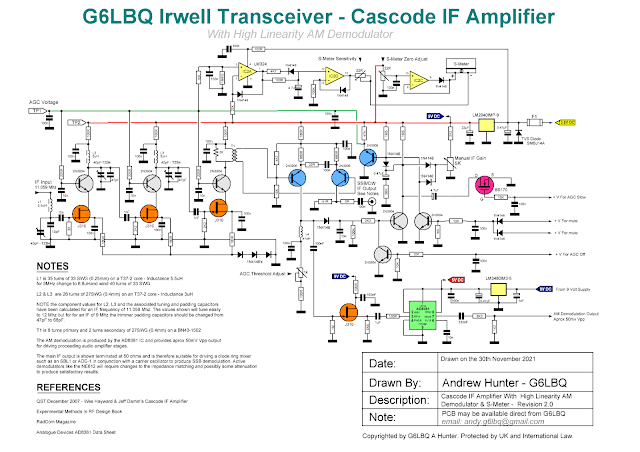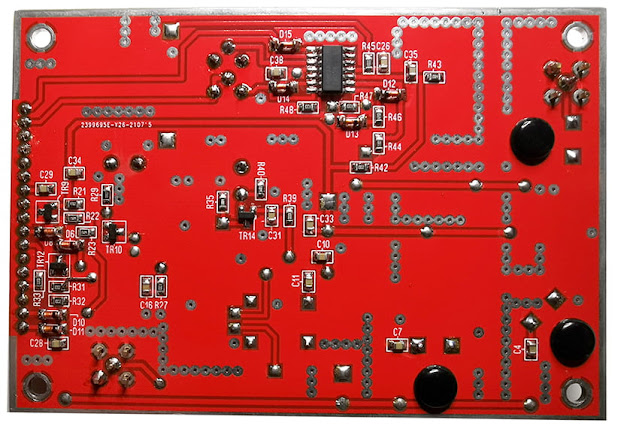For my original Cascode IF Amplifier article click here.
Cascode IF Amplifier Updates
"For The G6LBQ Irwell HF Transceiver"
Welcome to my blog post on the Cascode IF amplifier where, I address a problem that I discovered with the AM demodulator circuit and I also update the PCB to include the S-Meter electronics.
A note to self for future reference:
"pay closer attention to manufacturers' product data sheets"
The Cascode IF amplifier, which I featured in a blog post back in April 2021, has been working reasonably well and in particular, I have been very happy with the AM demodulation produced by the AD8361 mean -responding power detector IC.
Recently I began to notice a peculiarity when listening to SSB signals. The AGC seemed to be less effective with weaker SSB signals, with the demodulated audio sounding a little quieter, as if the IF gain was not being increased by the AGC on some signals. Initially I thought it was poor alignment of the AGC threshold preset but no amount of adjustment seemed to improve matters.
To investigate the problem further, I decided to hook up the IF amplifier to my spectrum analyser. I fed the IF input with the tracking generator whilst monitoring the output on the analyser and the AGC line on my oscilloscope.
Whilst varying the amplitude of the signal to the IF amplifier input, I was able to see that the AGC was not very responsive to weak signals, which confirmed my suspicions that there was indeed a problem.
My inherent instinct was to remove the AD8361 am demodulator from the AGC detector to see if this improved the AGC action and, sure enough, it did, the AGC sprung into life on the weaker signals. The AD8361 IC in its current configuration is clearly having a loading effect on the AGC detector.
In order to try and understand why the AD8361 was, in effect dampening the AGC, I reached out to the Analog Devices data sheet to take a closer look at the manufacturing specifications and there screaming out at me on page 3 was the device's input impedance quoted at "225 ohms" so there lies the problem!
The input impedance of the AD8361 is fairly low and that is why it is having a dampening effect on the AGC detector. When I originally designed the circuit, I did not give thought to the AD8361's input impedance... Schoolboy error!
In the original prototype and schematic, I used a low value coupling capacitor (100pF) and low ohm resistor (100R) to connect the AD8361 to the AGC detector and wrongly assumed this would be fine. The recovered AM audio was excellent and the AGC worked nicely but my tests were carried out listening to broadcast radio stations, which had kilowatts of power at their disposal!
To remedy the problem, I increased the AD8361 coupling capacitor to 100nF and increased the value of the coupling resistor to 10K. This value was selected based on the point where I found the AGC was no longer being dampened.
The Cascode IF amplifier's AGC circuit now performs much better on the weaker signals and despite the component changes, the AM audio remains excellent.
Here is the revised schematic diagram to reflect the component changes made:
 |
| Click to enlarge to full size! |
Readers of my blog may have deduced that I am seldom satisfied with my achievements or endeavours, I am constantly in pursuit of improvements or better ways to do things and to categorize that I believe I have a condition I call "OTD" obsessive tinkering disorder.
During my most recent episode of OTD, I felt compelled to do yet another revision of the Cascode IF Amplifier. This version incorporates the S-Meter electronics and a high impedance FET buffer to interface the AD8361 AM demodulator to the AGC detector.
Here is the schematic for my version 2.0 Cascode IF amplifier:
 |
| Click to enlarge to full size! |
A new PCB has been produced for the Version 2.0 IF amplifier to accommodate the additional S-Meter electronics, I have also made provisions on the PCB for adding screening between the IF stages, though I have not experienced any issues to suggest this is needed. The PCB contains components on both the top and bottom layers.
Here is the Revision 2.0 PCB looking at the top layer with all components populated:
 |
| Actual PCB size is 110mm by 76mm |
And next, an image of the Revision 2.0 PCB looking at the bottom layer. Most of the S-Meter electronics is mounted on the bottom layer away from the main IF amplifier stages:
 |
| Actual PCB size is 110mm by 76mm |
The revision 2.0 IF amplifier is working nicely and I now have an S-Meter, previously I had intended to build the S-Meter circuit as a separate module but I am glad I have now included it on the one PCB.
The earlier IF amplifier is still an excellent module and I will continue to use it for projects that do not require an S-Meter and where space is a premium.
It should be noted that revision 2.0 of the IF amplifier performs the same as my first revision. If you have built or are contemplating building the original circuit, I advise that you replace the AD8361 coupling components as outlined.
In the next blog post, I will be starting work on the transmitter modules and presenting my AM, SSB & CW modulator.
NOTE: The receiver is complete though I have yet to try adding a second conversion stage, this is something I will be doing some time in the near future. Also I have not posted any information regarding the crystal IF filters that I am using. These were made back in 2015 but at some stage I will build some more filters and document the process on the blog.
As usual project files will be made available via the Groups.io platform by joining my G6LBQ community group, where you can discuss my projects, ask questions and help others.
Joining my group is free. Just click on the button below.
Until next time...





No comments:
Post a Comment
I appreciate your comments on the blog content, however the blog has been subject to idiots trying to use the comments facility as a means to post advertisements & spam so all comments are now approved and moderated.